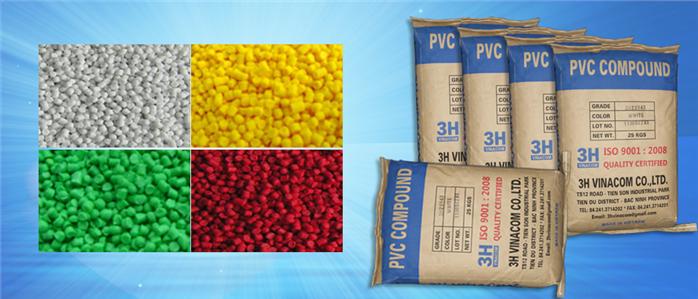
The PVC compound grades are included insulation and sheath application of wire and cable with temparature rating of less then 1050C and conform to the international and Vietnam standards such as ASTM D1505, UL 62, UL 94, IEC 60502, IEC 60227, TCVN 5935, TCVN 6610, RoSH directive 2002/95/EC and its amending directives.
Beside that special PVC properties are available upon customers requirement.
There also available some grades are produced with characteristics of durableness, termite resistance, heat resistance, flamable resistance, dull and gloss surface.
PVC compound is commonly used for a wide range of applications in sectors even very different from each other. The compounds are used for both rigid and flexible formulations.
Main flexible applications are spiral tubes, gaskets, crystal shoes and technical tubes, shoes, films, plates, medical and surgical devices and wires and cables (electric, telephone systems, telecommunications industry and plugs) are produced with excellent physical and technical performance.
Rigid applications they are mainly used for raceways, rolling shutters and window profiles, electric and hydraulic connections, spiral tubes and medical equipment, electronic equipment (office automation, conduits, electrical boxes).
SECTION 1. CHEMICAL PRODUCT AND COMPANY IDENTIFICATION
SECTION 2. COMPOSITION, INFORMATION ON INGREDIENTS
|
Component |
SYNONYMS |
CAS NO. |
Contents(%) |
|
1. PolyVinylChloride |
[ -CH2CHCL- ] |
9002-86-2 |
Business Secret |
|
2. Plasticizer |
DI OCTYL(NONYL) TEREPHTHALATE |
1003585-70-3 |
|
|
3. Filler |
CaCO3 |
1317-65-3 |
|
|
4. Antimony Trioxide |
Sb2O3 |
1309-64-4 |
|
|
5. Stabilizer |
NC-200P |
- |
|
|
6. Lubricant |
|
57-11-4 |
SECTION 3. HAZARDS INDENTIFICATION
SECTION 4. FIRST AID MEASURES
No specific Instruction Needed
SECTION 5. FIRE FIGHTING MEASURES
2. Special exposure hazard: Principal toxicant in the smoke is carbon monoxide.
SECTION 6. ACCIDENTAL RELEASE MEASURES
Use proper personal protective equipment as indicated in Section 8.
Suck or sweep up spill. All spill of granules must be removed immediately to prevent slipping accidents.
SECTION 7. HANDLING AND STORAGE
During processing and thermal treatment of the product, small amounts of volatile hydrocarbons
may be released. Provide adequate ventilation. Local exhaust ventilation may be necessary.
Avoid inhalation of dust and decomposition.
Dust from the product gives a potential risk for dust explosion. All equipment shall be grounded
No other specific storage requirements.
SECTION 8. EXPOSURE CONTROLS, PERSONAL PROTECTION
Provide adequate ventilation. Local exhaust ventilation may be necessary.
SECTION 9. PHYSICAL AND CHEMICAL PROPERTIES
|
Solid granules, odorless |
|
Black
|
|
Not available
|
|
Not available
|
|
Not available
|
|
Not available
|
|
Not available
|
|
Not available
|
|
90 ~ 130 deg C
|
|
Not available
|
|
Insoluble in water
|
|
1.45
|
|
Not available |
|
Not available |
SECTION 10. STABILITY AND REACTIVITY
The product is not considered dangerous for the environment
SECTION 11. TOXICOLOGICAL INFORMATION
SECTION 12. ECOLOGICAL INFORMATION
The product is not considered dangerous for the environment
SECTION 13. DISPOSAL CONSIDERATIONS
Check with local regulations.
SECTION 14. REGULATORY INFORMATION
TSCA
CAS No. 9002-88-4 is listed on the TSCA inventory.
Health & Safety Reporting List
None of the chemicals are on the Health & Safety Reporting List.
Chemical Test Rules
None of the chemicals in this product are under a Chemical Test Rule.
Section 12b
None of the chemicals are listed under TSCA section 12b.
TSCA Signification New Use Rule
None of the chemicals in this material have a SNUR under TSCA.
SARA
Section 302(RQ) : None of the chemicals in this material have an RQ
Section 302 (TPQ) : None of the chemicals in this product have a TPQ.
Section 313 : No chemicals are reportable under Section 313.
Clean air Act :
This material does not contain any hazardous air pollutants.
This material does not contain any class 1 Ozone depletors
This material does not contain any class 2 Ozone depletors
Clean Water Act :
None of the chemicals in this product are listed as hazardous substance under CWA
None of the chemicals in this product are listed as priority pollutants under the CWA.
None of the chemicals in this product are listed as toxic pollutants under the CWA.
OSHA :
None of the chemicals in this product are considered highly hazardous by OSHA.
SECTION 15. ADDITIONAL INFORMATION
The information above is believed to be accurate and represents the best information currently
available to us. However, we make no warranty of merchantability or any other warranty, express or implied,
with respect to such information, and we assume no liability resulting from its use. Users
should make their own investigations to determine the suitability of the information for their particular
purposes.
- THE END-
PVC compound is mainly packed 25 kgs in krapt bag, stacking on papplet.
Other packing according to customer order are available such as 750 kgs in bulk container.
PVC compound can be used in extruding, injection machine easily with the commonly heating profile:
|
Items |
Heater C1 |
Heater C2 |
Heater C3 |
Heater C4 |
Heater C5 |
Neck |
X-Head |
Die |
|
Temperature (oC) |
145oC |
150 oC |
155 oC |
160 oC |
165 oC |
165 oC |
165 oC |
170 oC |
|
Note: The above temperature can be changeable depending on the real heat dissemination of plated machine
|
||||||||
Manufacture recommend that customer turn on the dryer machine of material hopper at 700C. and should use the product within 12 months since manufacturing date because the normal or humid weather can make the insulation un-smooth.
Storage in the roofed warehouse, dry and ventilated to avoid humidity, insects, termites, mouse.
For the best quality, the Manufacture recommend that customer should have the good plan for production and buy materials within six months and manage those with confirmative rules to ensure that material be ready at any time and in good condition, to economize the expense for stock and capital circulation.